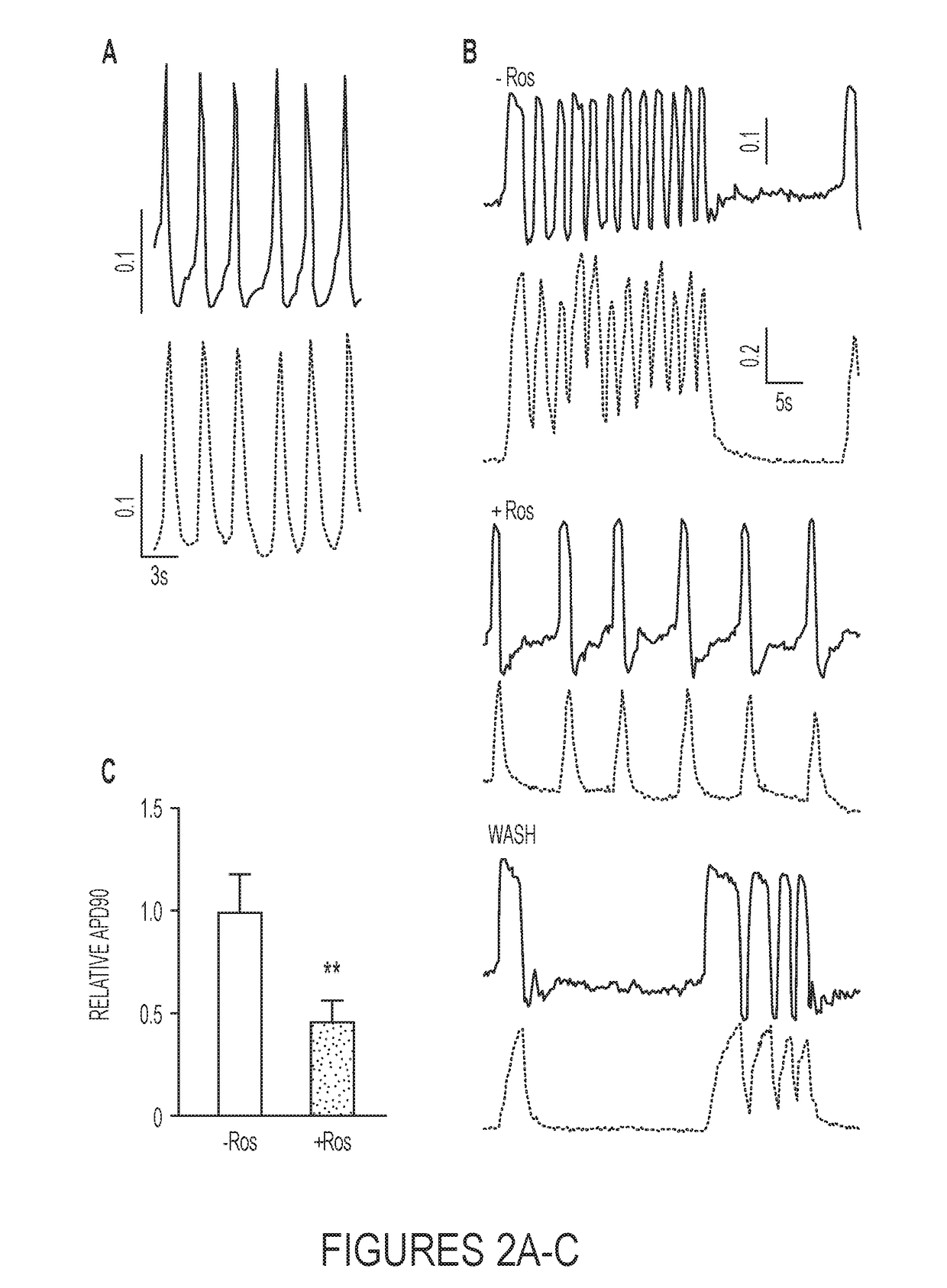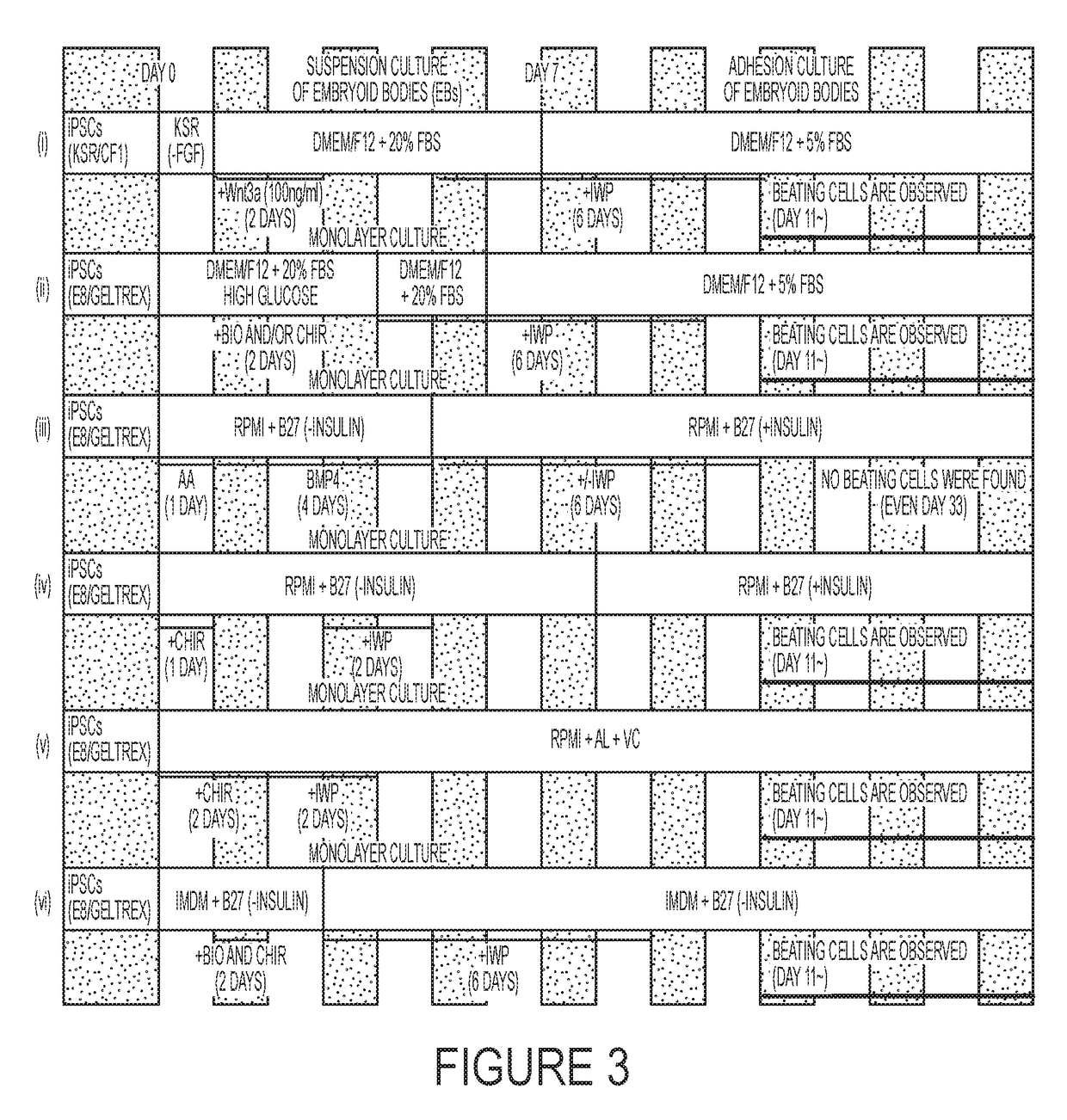Methods for Cardiac Differentiation of Human Induced Pluripotent Stem Cells
a human induced pluripotent stem cell and cardiac differentiation technology, applied in the field of monolayer cardiac differentiation techniques, can solve the problems of inapplicability, inefficiency in generating cardiomyocytes from pluripotent stem cells through eb formation, and high cost of recombinant proteins, and achieve the effect of significant increase in cell siz
- Summary
- Abstract
- Description
- Claims
- Application Information
AI Technical Summary
Benefits of technology
Problems solved by technology
Method used
Image
Examples
example 1
[0064]Transfection using electroporation is widely used for the reprogramming of human fibroblasts with the episomal vectors to generate integration / virus-free iPSCs (Okita et al., 2011; Yu et al., 2009). However, electroporation requires equipment, expertise and millions of cells to minimize toxicity and optimize the efficiency of gene transduction in each patient sample. In contrast, lipofection is a relatively simple procedure compared to electroporation, although repeated lipofection of modified RNA is required for reprogramming (Warren et al., Cell stem cell 7, 618-630(2010)). To develop a simple and inexpensive protocol for the reprogramming to pluripotency, we first optimized transfection in IMR90 human embryonic lung fibroblasts in 24-well plates using Lipofectamine 2000 (LF-2K). LF-2K has been used for gene transduction in mammalian primary cells such as cortical neurons (Krey et al., Nature neuroscience 16, 201-209, (2013)) to express yellow fluorescent protein (YFP). We f...
example 2
Serum Containing Protocol
[0068]The outline of the serum-containing protocol is shown in FIG. 1A. The iPSC lines are cultured in a 37° C., 20% oxygen incubator with commercial Essential 8 media in 6 well plates or 100 cm dishes coated with Geltrex before differentiation. The protocol involves the use of three chemicals, CHIR99021 (CHIR, GSK3 inhibitor, Axon MedChem) and BIO (GSK3 inhibitor IX, Calbiochem) and IWP-3 (Wnt inhibitor, Sigma-Aldrich). A single use of four different doses of BIO (1, 2, 4, 8 μM) and Four different doses of CHIR (5, 10, 15, 20 μM) for differentiation were tested during the optimization of this protocol (Table 1). The result demonstrated that single use of 1 μM BIO and 5 μM CHIR at day 2 and day 3 during the differentiation provided beating cardiomyocytes. We found that a combination of BIO and CHIR at day 2 and day 3 during differentiation further enhanced the differentiation efficiency and the dose of CHIR could be further reduced when it was used together ...
example 3
Serum-Free Protocol
[0071]The outline of this protocol is shown in FIG. 1E. The iPSC lines are cultured in a 37° C., 20% oxygen incubator with commercial Essential 8 media in 6 well plates or 100 cm dishes coated with Geltrex before differentiation. Three chemicals, CHIR99021 (CHIR, GSK3 inhibitor. Axon MedChem) and BIO (GSK3 inhibitor IX, Calbiochem) and IWP-3 (Wnt inhibitor, Sigma-Aldrich) are utilized in the serum-free protocol. The dose of each compound is the same as that used in the serum-containing protocol. BIO and CHIR are used for inducing mesoderm differentiation at Day 2. IWP-3 is used from Day 4 to Day 9. All chemicals are prepared in Dimethyl Sulfoxide (DMSO). IMDM-B27 (with or without insulin) media was used for cardiac differentiation and culture: B27 supplement with or without insulin and P.S. were added to Iscove's Modified Dulbecco's Medium (IMDM) media. IMDM B27 (without insulin) is used from Day 1 to Day 3 and IMDM B27 (with insulin) is used from Day 4 to Day 9 a...
PUM
| Property | Measurement | Unit |
|---|---|---|
| diameter | aaaaa | aaaaa |
| diameter | aaaaa | aaaaa |
| exposure time | aaaaa | aaaaa |
Abstract
Description
Claims
Application Information
 Login to View More
Login to View More - R&D
- Intellectual Property
- Life Sciences
- Materials
- Tech Scout
- Unparalleled Data Quality
- Higher Quality Content
- 60% Fewer Hallucinations
Browse by: Latest US Patents, China's latest patents, Technical Efficacy Thesaurus, Application Domain, Technology Topic, Popular Technical Reports.
© 2025 PatSnap. All rights reserved.Legal|Privacy policy|Modern Slavery Act Transparency Statement|Sitemap|About US| Contact US: help@patsnap.com



